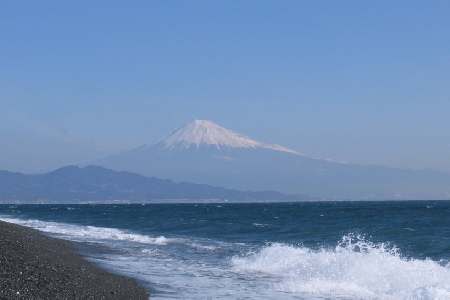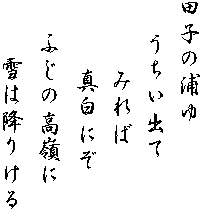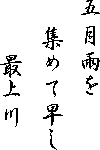Return Home
Top Previous Next
1. Prologue for nature and people
Japan has many scenic places in every part of her land.
We will describe here the characteristics of Japan's natural environment,
especially in relation to our unique weather and climates.
 As you may know, Japanese "Tanka” and “Haiku” are written in
order to express aesthetic sensitivity. These arts have been influenced by
Japan's unique weather and climate based on country's four distinct seasons.
Tanka(Japanese traditional poem)
One example can be seen in "Man-yo-shu" which is Japan's
oldest poem, created more than 1,300 years ago. Anyone,
regardless of his / her social rank, could have created "Man-yo-shu"
poem like this:
As you may know, Japanese "Tanka” and “Haiku” are written in
order to express aesthetic sensitivity. These arts have been influenced by
Japan's unique weather and climate based on country's four distinct seasons.
Tanka(Japanese traditional poem)
One example can be seen in "Man-yo-shu" which is Japan's
oldest poem, created more than 1,300 years ago. Anyone,
regardless of his / her social rank, could have created "Man-yo-shu"
poem like this:
When I take the path
To Tago's coast, I see
Perfect whiteness laid
On Mount Fuji's lofty peak
By the drift of falling snow.
|  |
(Remarks)
Above is a picturesque scene which shows the figure of Mt. Fuji
which can be seen from Tagono-ura seashore of the Suruga bay in
Shizuoka prefecture. People then stood there and saw the same
scenery as we see today. The author of the above poem "Aka-hito"
was supposed to be deeply impressed by the splendor of Mt. Fuji.
Regardless of time, Japanese people have always been influenced
by the climate and environment that surrounds them. This has
always influenced our way of life, thinking and souls.
Haiku
One more example: "Haiku" expresses an author's own feelings
which is greatly affected by the four distinct seasons in Japan.
Haiku started it's origin more than 300 years ago, and nowadays
it is internationally famous. And this can be seen by the 10,000,000 hits
it receives on the internet.
Here is a Haiku poem which the greatest Haiku author "Basho Matsuo" wrote:
Gathering as it goes
All the rains of early summer,
How swiftly the Mogami flows!
|  |
(Remarks)
If you have a chance to visit Yamagata prefecture in the Tohoku
region in May, you will see a similar scene near the Mogami river,
running down through the mountainous region.
These examples may be small, but are characteristics of Japan's
tradition. Now, we will discuss Japan's climate and environment
which have cultivated the Japanese way of life and way of thinking.
And we must not forget about the kind of world that we are handing
down to our children. In the next section we will discuss the
effects on Japanese words the weather has had on our culture.
Top Previous Next
Contact us
 As you may know, Japanese "Tanka” and “Haiku” are written in
order to express aesthetic sensitivity. These arts have been influenced by
Japan's unique weather and climate based on country's four distinct seasons.
Tanka(Japanese traditional poem)
One example can be seen in "Man-yo-shu" which is Japan's
oldest poem, created more than 1,300 years ago. Anyone,
regardless of his / her social rank, could have created "Man-yo-shu"
poem like this:
As you may know, Japanese "Tanka” and “Haiku” are written in
order to express aesthetic sensitivity. These arts have been influenced by
Japan's unique weather and climate based on country's four distinct seasons.
Tanka(Japanese traditional poem)
One example can be seen in "Man-yo-shu" which is Japan's
oldest poem, created more than 1,300 years ago. Anyone,
regardless of his / her social rank, could have created "Man-yo-shu"
poem like this:

